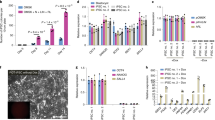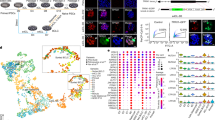Abstract
The derivation of human embryonic stem (hES) cells currently requires the destruction of ex utero embryos1,2,3,4. A previous study in mice indicates that it might be possible to generate embryonic stem (ES) cells using a single-cell biopsy similar to that used in preimplantation genetic diagnosis (PGD), which does not interfere with the embryo’s developmental potential5. By growing the single blastomere overnight, the resulting cells could be used for both genetic testing and stem cell derivation without affecting the clinical outcome of the procedure. Here we report a series of ten separate experiments demonstrating that hES cells can be derived from single blastomeres. In this proof-of-principle study, multiple biopsies were taken from each embryo using micromanipulation techniques and none of the biopsied embryos were allowed to develop in culture. Nineteen ES-cell-like outgrowths and two stable hES cell lines were obtained. The latter hES cell lines maintained undifferentiated proliferation for more than eight months, and showed normal karyotype and expression of markers of pluripotency, including Oct-4, SSEA-3, SSEA-4, TRA-1-60, TRA-1-81, nanog and alkaline phosphatase. These cells retained the potential to form derivatives of all three embryonic germ layers both in vitro and in teratomas. The ability to create new stem cell lines and therapies without destroying embryos would address the ethical concerns of many, and allow the generation of matched tissue for children and siblings born from transferred PGD embryos.
This is a preview of subscription content, access via your institution
Access options
Subscribe to this journal
Receive 51 print issues and online access
$199.00 per year
only $3.90 per issue
Buy this article
- Purchase on Springer Link
- Instant access to full article PDF
Prices may be subject to local taxes which are calculated during checkout




Similar content being viewed by others
References
Lanza, R. et al. (eds) Essentials of Stem Cell Biology (Elsevier/Academic, San Diego, 2006)
Thomson, J. A. et al. Embryonic stem cell lines derived from human blastocysts. Science 282, 1145–1147 (1998)
Cowan, C. A. et al. Derivation of embryonic stem-cell lines from human blastocysts. N. Engl. J. Med. 350, 1353–1356 (2004)
Strelchenko, N. et al. Morula-derived human embryonic stem cells. Reprod. BioMed. 9, 623–629 (2004)
Chung, Y. et al. Embryonic and extraembryonic stem cell lines derived from single mouse blastomeres. Nature 439, 216–219 (2006)
Veeck, L. L. et al. An Atlas of Human Gametes and Conceptuses (Parthenon, New York, 1999)
Nagy, A., Gertsenstein, M., Vintersten, K. & Behringer, R. (eds) Manipulating the Mouse Embryo: A Laboratory Manual (Cold Spring Harbor Laboratory Press, Cold Spring Harbor, 2002)
Klimanskaya, I. & McMahon, J. in Handbook of Stem Cells Vol. 1 Embryonic Stem Cells (eds Lanza, R. et al.) 437–449 (Elsevier/Academic, San Diego, 2004)
Klimanskaya, I. et al. Human embryonic stem cells derived without feeder cells. Lancet 361, 1496–1501 (2005)
Klimanskaya, I. et al. Derivation and comparative assessment of retinal pigment epithelium from human embryonic stem cells using transcriptomics. Clon. Stem Cells 6, 217–245 (2004)
Lanzendorf, S. E. et al. Use of human gametes obtained from anonymous donors for the production of human embryonic stem cell lines. Fertil. Steril. 76, 132–137 (2001)
Mitalipova, M. et al. Human embryonic stem cell lines derived from discarded embryos. Stem Cells 21, 521–526 (2003)
Weber, D. J. Considerations for clinical uses of therapies derived from stem cells. In Methods in Enzymology Vol. 420 Stem Cell Tools and Therapeutic Applications (eds Klimanskaya, I. & Lanza, R.) (Elsevier, New York, in the press)
Richards, M., Fong, C. Y., Chan, W. K., Wong, P. C. & Bongso, A. Human feeders support prolonged undifferentiated growth of human inner cell masses and embryonic stem cells. Nature Biotechnol. 20, 933–936 (2002)
Ludwig, T. E. et al. Derivation of human embryonic stem cells in defined conditions. Nature Biotechnol. 24, 185–187 (2006)
Young, H., Xu, C. & Carpenter, M. K. in Essentials of Stem Cell Biology (eds Lanza, R. et al.) 317–324 (Elsevier/Academic, San Diego, 2006)
Deb, K., Sivaguru, M., Yong, H. Y. & Roberts, R. M. Cdx2 gene expression and trophectoderm lineage specification in mouse embryos. Science 311, 992–996 (2006)
Piotrowska-Nitsche, K., Perea-Gomez, A., Haraguchi, S. & Zernicka-Goetz, Z. Four-cell stage mouse blastomeres have different developmental properties. Development 132, 479–490 (2005)
Hansis, C., Tang, Y., Grifo, J. A. & Krey, L. C. Analysis of Oct-4 expression and ploidy in individual human blastomeres. Mol. Hum. Reprod. 7, 155–161 (2001)
Geber, S., Winston, R. M. L. & Handyside, A. H. Proliferation of blastomeres from cleavage stage human embryos in vitro: an alternative to blastocyst biopsy for preimplantation diagnosis. Hum. Reprod. 10, 1492–1496 (1995)
Sills, E. S., Takeuchi, T., Tanaka, N., Queenie, V. N. & Palermo, G. D. Identification and isolation of embryonic stem cells in reproductive endocrinology: theoretical protocols for conservation of human embryos derived from in vitro fertilization. Theor. Biol. Med. Model 2, 25 (2005)
Handyside, A. H. et al. Pregnancies from biopsied human preimplantation embryos sexed by Y-specific DNA amplification. Nature 344, 768–770 (1990)
Magli, M. C. et al. Cryopreservation of biopsied embryos at the blastocyst stage. Hum. Reprod. doi:10.1093/humrep/del228 (published online 12 June 2006)
Hardy, K., Martin, K. L., Leese, H., Winston, R. M. & Handyside, A. Human preimplantation development in vitro is not adversely affected by biopsy at the 8-cell stage. Hum. Reprod. 5, 708–714 (1990)
Staessen, C. et al. Comparison of blastocyst transfer with or without preimplantation genetic diagnosis for aneuploidy screening in couples with advanced maternal age: a prospective randomized controlled trial. Hum. Reprod. 19, 2849–2858 (2004)
Fredsted, T. & Villesen, P. Fast and reliable sexing of prosimian and human DNA. Am. J. Pathol. 64, 345–350 (2004)
Koopman, P., Gubbay, J., Vivian, N., Goodfellow, P. & Lovell-Badge, R. Male development of chromosomally female mice transgenic for Sry. Nature 351, 117–121 (1991)
Acknowledgements
We thank T. Li and A. Feng for their assistance with hES cell culture and differentiation, S. Agarwal, J. Shepard and T. Lin for RT–PCR, J. Johnson and L. Meisner for karyotype analysis, and J. Staruk and L. McGill for histological analysis.
Author information
Authors and Affiliations
Corresponding author
Ethics declarations
Competing interests
The hES cell lines generated in this study will be made available to investigators under a material transfer agreement (an application has been submitted for deposition of the hES cell lines into the UK Stem Cell Bank). Reprints and permissions information is available at www.nature.com/reprints. The authors declare competing financial interests: details accompany the paper at www.nature.com/nature.
Supplementary information
Supplementary Figure 1
Original DNA gels. a–c, uncropped gels for Figure 4 a-c, respectively. d, uncropped gel for Figure 3i. (JPG 24 kb)
Rights and permissions
About this article
Cite this article
Klimanskaya, I., Chung, Y., Becker, S. et al. Human embryonic stem cell lines derived from single blastomeres. Nature 444, 481–485 (2006). https://doi.org/10.1038/nature05142
Received:
Accepted:
Published:
Issue Date:
DOI: https://doi.org/10.1038/nature05142
This article is cited by
-
Regenerative medicine: current research and perspective in pediatric surgery
Pediatric Surgery International (2023)
-
Bacterial Lipase Neutralized Toxicity of Lipopolysaccharide on Chicken Embryo Cardiac Tissue
Cardiovascular Toxicology (2021)
-
Stem cells: a potential treatment option for kidney diseases
Stem Cell Research & Therapy (2020)
-
Ethical challenges regarding the use of stem cells: interviews with researchers from Saudi Arabia
BMC Medical Ethics (2020)
-
Identification and characterization of two morphologically distinct stem cell subpopulations from human urine samples
Science China Life Sciences (2020)
Comments
By submitting a comment you agree to abide by our Terms and Community Guidelines. If you find something abusive or that does not comply with our terms or guidelines please flag it as inappropriate.



